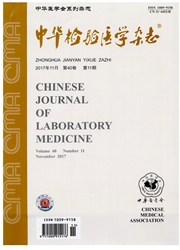

 中文摘要:
中文摘要:
血栓实验室检查的临床应用可分为四类,包括风险评估、排除诊断、辅助诊断和治疗监测。有循证依据并被纳入国际主流血栓防治指南的项目包括凝血酶原时间、活化部分凝血活酶时间、抗因子Ⅹa活性、D-二聚体、凝血因子Ⅷ、抗凝血蛋白、抗磷脂综合征相关指标、肝素诱导的血小板减少症抗体以及血小板聚集试验等,为临床干预和制定抗栓策略提供重要依据。其他多数血栓试验尚缺乏足够的循证证据,因此需要积极参与多中心临床随机对照研究,主动进行系统评价和荟萃分析,解决基于PICO构建的临床问题,推动实验室指标的临床应用。
 英文摘要:
英文摘要:
The clinical application of the laboratory examination with thrombosis can be divided into four categories, including risk assessment, diagnosis by exclusion, auxiliary diagnosis and therapic monitoring. Theevidence based parameters which subsumed into the international guidelines of thrombosis related clinical management, included the prothrombin time, activited partial thomboplastin time, anti-factor Ⅹa activity, D-dimer, coagulation factorⅧ, naturally occurring anticoagulants, antiphospholipid syndromeassociative parameters, heparin induced thrombocytopenia antibodies and platelet aggregation test, which provided the important evidence for clinical intervention and establishment of antithrombotic strategy. Theother thrombosis tests are still lack of sufficient evidence, therefore we need to participate in multicentric clinical randomized controlled study actively, and implementing the systematic review and meta-analysis forwardly, solving clinical questions based on PICO(Patients, Intervention, Comparision, Outcome), promoting the clinical application of laboratory parameters.
 同期刊论文项目
同期刊论文项目
 同项目期刊论文
同项目期刊论文
 期刊信息
期刊信息
